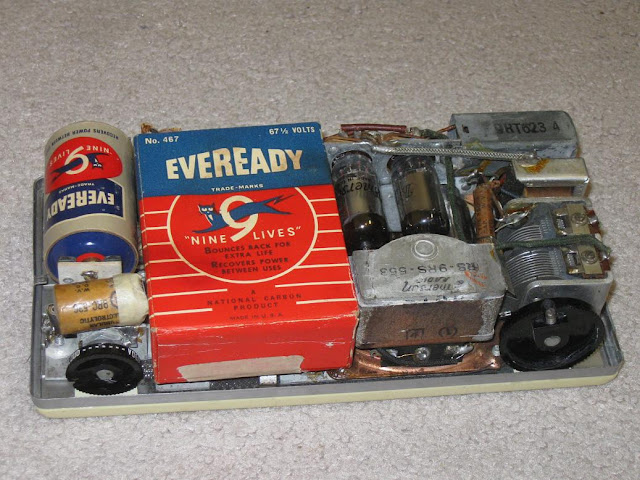Although personal electronics got
its start prior to WWII its impetus was cut short. In April of 1942 production of radios as well
as most other consumer electronics was stopped for the duration of the war. Production of electronics for civilian uses
did not resume until late 1945. So, for
almost three years there were no new radios, televisions, or phonographs. When production resumed the demand was so
great that shortages developed due to lack of critical components. Nevertheless, the post war radio production
was huge compared to the number of prewar radios produced.
Personal radios, like the RCA
BP-10, were only available from the summer of 1940 until the April 1942
production stoppage. RCA redesigned
their line of personal radios after the war and came out with a series of
personal portables including their models 2B401, B411, and the gold plated 54B5.
Other manufacturers dusted off their
prewar personal radio designs and produced them essentially unchanged from their
prewar versions. Examples include the
Motorola model 5A1, which was identical to the prewar A1. Some manufactures redesigned their personal
radios to add improvements. The Emerson
model 508 of 1946 is basically an improved version of the prewar model 432
personal radio. A few manufacturers just
ignored the personal radio market to concentrate on television and other
electronics. Zenith was one such
company. Zenith produced their model
4K600 “Poketradio” personal portable prior
to the war, but did not offer another personal portable radio until transistors
were available in the mid 1950s. Instead,
Zenith concentrated on sales of their large multi-band “Transoceanic” portable
radio.
Since, the production of prewar
personal portables lasted only a few years the number available to collectors and
restorers is very limited. Also, many
were thrown away due to battery corrosion and obsolescence (transistors were
the new craze). By the 1960s the high
voltage batteries required for the tubes were expensive and becoming hard to
find. Those surviving are primarily the
radios produced in the highest volume.
The RCA BP-10 is a good example of a popular prewar personal portable
that is often seen on eBay and other sales venues. Production totaled more the 200,000, which is
pretty amazing for the time. Other
portables that seem moderately common include the Motorola A1, Emerson 432, and
Zenith model 4K600 “Poketradio”. There
are a lot of very rare sets that apparently were poor sellers or not rugged
enough to survive. Among those might be
the Crosley model 45 “Commuter” and the Lafayette
model E-191.
A few pre WWII personal portable radios
including: A. Knight - B10506,
B. Fada - 33, C. Motorola - A1,
and D. Emerson – 432
Collecting and restoring personal portable
radios has some advantages over collecting and restoring table top or console
radios. Obviously, personal portable
radios are much smaller. Also, they also
tend to be cheaper, because there currently isn’t much interest in them
compared to other types. Transistor
radios seem to be an exception. But, the
transistor radio collectors generally ignore most of the early tube based
portables.
There are a few drawbacks to
collecting tube portables. One drawback,
as previously mentioned, is their comparative rarity. Personal portables were manufactured for two
years before WWII and for about ten years after the war. They were not promoted heavily by the radio
manufacturers, probably because they were rather inexpensive to begin
with. Lastly, they were generally a
secondary radio sold to those going places without reliable AC power. Since they were inexpensive many were
replaced by transistor radio when they became available. The tube portables were often junked. The really rare tube portables seem to be the
personal portable battery only models.
Since these could not be run from the AC line they were of limited
interest to the buying public. True
battery only portables appeared in 1939.
By 1942, when radio production was suspended for the war, sales of battery
only portable radios were only about a third the number of portables capable
and battery and line AC/DC line operation.
Most of the battery only radios seem to have been bought as personal
radios for travel, camping, and other activities were small size was of
overriding importance.
Electrical restoration of battery
powered tube portables is usually straight forward. The original circuit components were rarely
stressed to the same degree as in AC line operated radios. The low power dissipation and circuit
voltages were generally much less than the components were designed to
handle. Many 70 and 80 year old portable
radios will play just fine with most of their original parts. The exception is polarized capacitors. They almost always need replacing. Fortunately, most battery only radios rarely
have more than one polarized capacitor.
After replacing that capacitor the radio will most likely play as it did
when new.
An early tube portable radio in
working condition is a true window into the history of portable electronics.
The next time someone demonstrates their latest smart phone it might be a good
time to show them where it all started.
The fact that hand carried electronics existed that long ago is often a
surprise to non radio enthusiasts.







